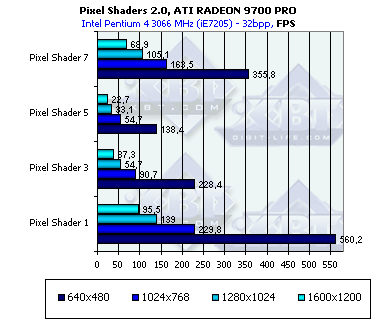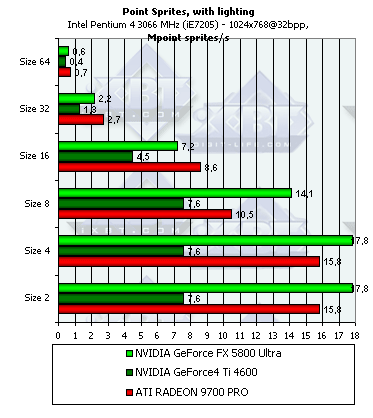NVIDIA GeForce FX 5800 Ultra 128MB
|
As usual, before we proceed to analysis of the new accelerator we recommend
that you read the analytic article scrutinizing the architecture and specifications
of the NVIDIA GeForce FX (NV30)
CONTENTS
-
General
information
-
Peculiarities
of the NVIDIA GeForce FX 5800 Ultra 128MB video card
-
Test
system configuration and drivers' settings
-
Test
results: briefly on 2D
-
RightMark3D
synthetic tests: philosophy and tests description
-
Test
results: RightMark3D: Pixel Filling
-
Test
results:
RightMark3D: Geometry Processing Speed
-
Test
results:
RightMark3D: Hidden Surface Removal
-
Test
results:
RightMark3D: Pixel Shading
-
Test
results:
RightMark3D: Point Sprites
-
Test
results:
3DMark2001 SE synthetic tests
-
Additional
theoretical information and summary on the synthetic tests
-
Information
on anisotropic filtering and anti-aliasing
-
Architectural
features and prospects
-
Test
results: 3DMark2001 SE: Game1
-
Test
results:
3DMark2001 SE: Game2
-
Test
results:
3DMark2001 SE: Game3
-
Test
results:
3DMark2001 SE: Game4
-
Test
results:
3DMark03: Game1
-
Test
results:
3DMark03: Game2
-
Test
results:
3DMark03: Game3
-
Test
results:
3DMark03: Game4
-
Test
results:
Quake3 ARENA
-
Test
results:
Serious Sam: The Second Encounter
-
Test
results:
Return to Castle Wolfenstein
-
Test
results:
Code Creatures DEMO
-
Test
results:
Unreal Tournament 2003 DEMO
-
Test
results:
AquaMark
-
Test
results:
RightMark 3D
-
Test
results:
DOOM III Alpha version
-
3D
quality: Anisotropic filtering
-
3D
quality:
Anti-aliasing
-
3D
quality in general
-
Conclusion
Pixel Shading
This test is only for R300 and NV30 as the hardware execution of pixel
shaders 2.0 is the minimal requirement here. On the good old GeForce4 Ti
4600 coupled with 2 GHz Pentium 4 the software emulation of the pixel shaders
2.0 provides only one frame per 2 seconds in the small window.
-
Shaders 2.0:

What a surprise! In case of complicated texture sampling the NV30 is sometimes
twice as good as the R300, but in case of pixel calculations within the
shaders 2.0 it performs twice worse than the R300! Thus, the floating-point
operations are carried out on the NV30 twice slower than integer ones.
And according to the test, they are twice slower than on the R300. Well,
this is again the cost of flexibility. The pixel pipeline of the NV30 is
much more flexible, it is not limited by the PS 2.0 and allows or a large
number of instructions and constants including instructions with logic
predicates. Is such cost worth paying? It is only if the developers are
going to use widely these additional features for the NV30 architecture.
But will they? The experience tells me that they will go only with the
maximum common multiple between ATI and NVIDIA, i.e. in this case it will
be PS 2.0, probably with additional modifiers from PS 2.X that support
R300 and NV30. But additional instructions and constants will hardly be
enabled.
One of the reason of such loss is that the NV30 stores constants as
additional instructions in the shader's code. Probably, such instructions
used for constants require both memory and clocks.
-
Let's see whether the results change in case of forcing floating-point
calculations with 16bit (half) precision possible in PS 2.X:


No difference - even if the half-precision forcing really takes place,
it doesn't affect the speed of calculations. Undoubtedly, the pixel shaders
will be further improved for compilation in the drivers, but I doubt that
such big advantage of the R300 will be outdone. Let's wait for R400 and
NV40 which promise to be both flexible and very fast in dealing with pixel
and vertex shaders.
-
Finally, the dependence on resolution for both chips:


Well, everything depends only on the number of shaded pixels.
Point Sprites
-
With lighting and without, depending on size:


As expected, the lighting influences only small sprites; in case of big
ones the performance is limited by the fill rate. The BORDER=1 is at the
size of 8. So, for rendering systems of a big number of particles the size
should be less than 8. Up to 8 NVIDIA outsmarts ATI - the decrease is not
so noticeable, it is monotonous and small. ATI starts losing badly between
4 and 8. But in case of big sprites it is the NV30's turn to lose - because
of shortage of the memory throughput.
The peak values are achieved without lighting and run into a bit over
21 M sprites per second for the RADEON 9700 PRO and a bit over 24 for GeForce
FX 5800 Ultra.
But the point sprites are not the cure-all, the figures are not much
better than with usual polygons. However, the point sprites are handier
in programming and, first of all, for all possible systems of particles.
-
Let's see how animation and shader version influences the performance:

Well, the animation's contribution is not great but noticeable, irrespective
of the VS version.
Here we finish the first broad benchmarking using the synthetic tests for
API DX9 from 3D.
[ Previous Part (3) ]
[ Next Part (5) ]
Write a comment below. No registration needed!
|
|
 |
|
|
|








